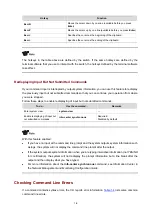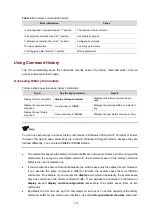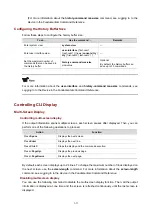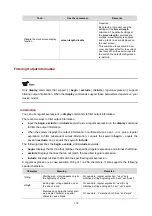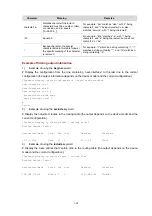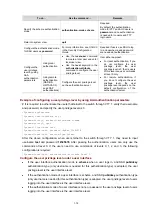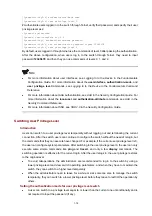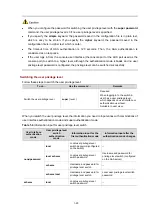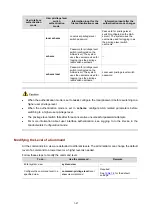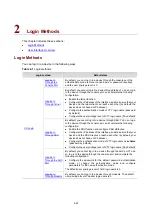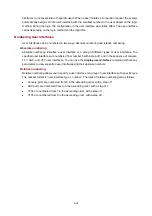
1-12
To do…
Use the command…
Remarks
Disable the multi-screen display
function
screen-length disable
Required
By default, a login user uses the
settings of the
screen-length
command. The default settings of
the
screen-length
command are:
multiple-screen display is enabled
and up to 24 lines are displayed on
the next screen.
This command is executed in user
view, and takes effect for the current
user only. When the user re-logs into
the switch, the default configuration
is restored.
Filtering Output Information
Only
display
commands that support
|
{
begin
|
exclude
|
include
}
regular-expression
] support
filtering output information. When the
display
commands support these parameters depends on your
device model.
Introduction
You can use regular expressions in
display
commands to filter output information.
There are two ways to filter output information.
z
Input the
begin
,
exclude
, or
include
keyword plus a regular expression in the
display
command
to filter the output information.
z
When the system displays the output information in multiple screens, use
/
,
-
or
+
plus a regular
expression to filter subsequent output information.
/
equals the keyword
begin
,
-
equals the
keyword
exclude
, and
+
equals the keyword
include
.
The following describes the
begin
,
exclude
, and
include
keywords:
z
begin
: Displays the first line that matches the specified regular expression and all lines that follow.
z
exclude
: Displays the lines that do not match the specified regular expression.
z
include
: Displays all lines that match the specified regular expression.
A regular expression is a case sensitive string of 1 to 256 characters. It also supports the following
special characters.
Character
Meaning
Remarks
^string
Starting sign.
string
appears only at
the beginning of a line.
For example, regular expression “^user” only
matches a string beginning with “user”, not “Auser”.
string$
Ending sign.
string
appears only at
the end of a line.
For example, regular expression "user$” only
matches a string ending with “user”, not “userA”.
.
Matches any single character, such
as a single character, a special
character, and a blank.
For example, “.l” matches both “vlan” and “mpls”.












